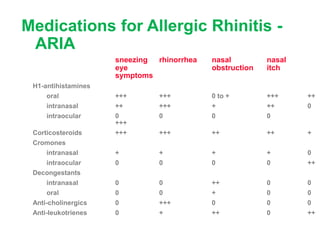Allergic rhinitis involves inflammation of the nasal mucosa triggered by an IgE-mediated response to allergens. It is very common, affecting about 40 million people in the US, with onset typically occurring in childhood. Symptoms include sneezing, rhinorrhea, nasal congestion and itchiness. Management involves allergen avoidance, pharmacotherapy like antihistamines and intranasal corticosteroids, and immunotherapy. Allergic rhinitis can negatively impact quality of life and is associated with increased risk of conditions like asthma and sinusitis.






![Pathophysiology
• Over 4-8 hours, these mediators, through a complex
interplay of events, lead to the recruitment of other
inflammatory cells to the mucosa, such as neutrophils,
eosinophils, lymphocytes, and macrophages.
• This results in continued inflammation, termed the late-
phase response.
• The symptoms of the late-phase response are similar to
those of the early phase, but less sneezing and itching
and more congestion and mucus production tend to
occur.[13]
• The late phase may persist for hours or days.](https://image.slidesharecdn.com/arinpedia-230708144026-b412025c/85/ar-in-pedia-pptx-7-320.jpg)
![Epidemiology
Frequency: Allergic rhinitis affects approximately 40 million people in
the United States. Recent US figures suggest a 20% cumulative
prevalence rate. Scandinavian studies have demonstrated a
cumulative prevalence rate of 15% in men and 14% in women.[17]
The prevalence of allergic rhinitis may vary within and among
countries. This may be due to geographic differences in the types
and potency of different allergens and the overall aeroallergen
burden.
Mortality/Morbidity- While allergic rhinitis itself is not life-threatening
(unless accompanied by severe asthma or anaphylaxis), morbidity
from the condition can be significant. Allergic rhinitis often coexists
with other disorders, such as asthma, and may be associated with
asthma exacerbations.](https://image.slidesharecdn.com/arinpedia-230708144026-b412025c/85/ar-in-pedia-pptx-8-320.jpg)




































